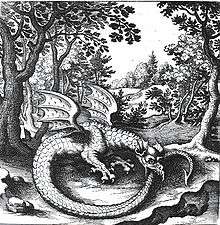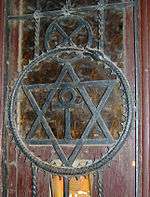Ouroboros

The ouroboros (/ˌjʊərəˈbɒrəs, ˌjʊəroʊ-/;[2] Ancient Greek: οὐροβόρος [ὄφις] < οὐρά (tail) + βόρος (devouring) "tail-devouring (snake)"[3]) is an ancient symbol depicting a serpent or dragon eating its own tail.
Originating in Ancient Egyptian iconography, the ouroboros entered western tradition via Greek magical tradition and was adopted as a symbol in Gnosticism and Hermeticism, and most notably in alchemy. Via medieval alchemical tradition, the symbol entered Renaissance magic and modern symbolism, often taken to symbolize, introspection, the eternal return or cyclicality,[4] especially in the sense of something constantly re-creating itself. It also represents the infinite cycle of nature's endless creation and destruction, life and death.[5]
Historical representations
Ancient Egypt
The first known appearance of the ouroboros motif is in the Enigmatic Book of the Netherworld, an ancient Egyptian funerary text in KV62, the tomb of Tutankhamun, in the 14th century BC. The text concerns the actions of the god Ra and his union with Osiris in the underworld. In an illustration from this text, two serpents, holding their tails in their mouths, coil around the head and feet of an enormous god, who may represent the unified Ra-Osiris. Both serpents are manifestations of the deity Mehen, who in other funerary texts protects Ra in his underworld journey. The whole divine figure represents the beginning and the end of time.[6]
The ouroboros appears elsewhere in Egyptian sources, where, like many Egyptian serpent deities, it represents the formless disorder that surrounds the orderly world and is involved in that world's periodic renewal.[7] The symbol persisted in Egypt into Roman times, when it frequently appeared on magical talismans, sometimes in combination with other magical emblems.[8] The 4th-century AD Latin commentator Servius was aware of the Egyptian use of the symbol, noting that the image of a snake biting its tail represents the cyclical nature of the year.[9]
Classical Antiquity

In Greek literature, Plato at his work Timaeus described the ouroboros as the first living thing created in the universe which became the earth itself.[5]
The living being had no need of eyes because there was nothing outside of him to be seen; nor of ears because there was nothing to be heard; and there was no surrounding atmosphere to be breathed; nor would there have been any use of organs by the help of which he might receive his food or get rid of what he had already digested, since there was nothing which went from him or came into him: for there was nothing beside him. Of design he created thus; his own waste providing his own food, and all that he did or suffered taking place in and by himself. For the Creator conceived that a being which was self-sufficient would be far more excellent than one which lacked anything; and, as he had no need to take anything or defend himself against any one, the Creator did not think it necessary to bestow upon him hands: nor had he any need of feet, nor of the whole apparatus of walking; but the movement suited to his spherical form which was designed by him, being of all the seven that which is most appropriate to mind and intelligence; and he was made to move in the same manner and on the same spot, within his own limits revolving in a circle. All the other six motions were taken away from him, and he was made not to partake of their deviations. And as this circular movement required no feet, the universe was created without legs and without feet.[10][11]
Plato's description of universe in terms of an Ouroboros portrays the cycle of life of all beings on the earth. It shows that all of nature is interconnected.[12]
In Gnosticism, a serpent biting its tail symbolized eternity and the soul of the world. The Gnostic text Pistis Sophia describes the Ouroboros as a 12-part dragon surrounding the world with his tail in his mouth.[13]
Alchemy

The famous ouroboros drawing from the early alchemical text The Chrysopoeia of Cleopatra (Greek: Η χρυσοποιία της Κλεοπάτρας) dating to 2nd century Alexandria encloses the words hen to pan (Greek: εν το παν), "one is the all". Its black and white halves represent the Gnostic duality of existence. As such, the Ouroboros could be interpreted as the Western equivalent of the Taoist Yin-Yang symbol.
The Chrysopoeia Ouroboros of Cleopatra the Alchemist is one of the oldest images of the ouroboros to be linked with the legendary opus of the alchemists, the Philosopher’s Stone.
As a symbol of the eternal unity of all things, the cycle of birth and death from which the alchemist sought release and liberation, it was familiar to the alchemist/physician Sir Thomas Browne. In his A Letter to a Friend, a medical treatise full of case-histories and witty speculations upon the human condition, he wrote of it:
[...] that the first day should make the last, that the Tail of the Snake should return into its Mouth precisely at that time, and they should wind up upon the day of their Nativity, is indeed a remarkable Coincidence,
"World serpent" in mythology

In Norse mythology, the ouroboros appears as the serpent Jörmungandr, one of the three children of Loki and Angrboda, which grew so large that it could encircle the world and grasp its tail in its teeth. In the legends of Ragnar Lodbrok, such as Ragnarssona þáttr, the Geatish king Herraud gives a small lindworm as a gift to his daughter Þóra Town-Hart after which it grows into a large serpent which encircles the girl's bower and bites itself in the tail. The serpent is slain by Ragnar Lodbrok who marries Þóra. Ragnar later has a son with another woman named Kráka and this son is born with the image of a white snake in one eye. This snake encircled the iris and bit itself in the tail, and the son was named Sigurd Snake-in-the-Eye.[14]

It is a common belief among indigenous people of the tropical lowlands of South America that waters at the edge of the world-disc are encircled by a snake, often an anaconda, biting its own tail.[15]
India
Ouroboros symbolism has been used to describe Kundalini energy. According to the medieval Yoga-kundalini Upanishad, "The divine power, Kundalini, shines like the stem of a young lotus; like a snake, coiled round upon herself she holds her tail in her mouth and lies resting half asleep as the base of the body" (1.82).
Storl (2004) also refers to the "ouroboros" image in reference to the "cycle of samsara".[16]
Modern references
Jungian psychology
Swiss psychologist Carl Jung saw the ouroboros as an archetype and the basic mandala of alchemy. Jung also defined the relationship of the ouroboros to alchemy:[17]
The alchemists, who in their own way knew more about the nature of the individuation process than we moderns do, expressed this paradox through the symbol of the Ouroboros, the snake that eats its own tail. The Ouroboros has been said to have a meaning of infinity or wholeness. In the age-old image of the Ouroboros lies the thought of devouring oneself and turning oneself into a circulatory process, for it was clear to the more astute alchemists that the prima materia of the art was man himself. The Ouroboros is a dramatic symbol for the integration and assimilation of the opposite, i.e. of the shadow. This 'feed-back' process is at the same time a symbol of immortality, since it is said of the Ouroboros that he slays himself and brings himself to life, fertilizes himself and gives birth to himself. He symbolizes the One, who proceeds from the clash of opposites, and he therefore constitutes the secret of the prima materia which [...] unquestionably stems from man's unconscious.
The Jungian psychologist Erich Neumann writes of it as a representation of the pre-ego "dawn state", depicting the undifferentiated infancy experience of both mankind and the individual child.[18]
Kekulé's dream
.png)
The German organic chemist August Kekulé described the eureka moment when he realized the structure of benzene:[19]
I was sitting, writing at my text-book; but the work did not progress; my thoughts were elsewhere. I turned my chair to the fire and dozed. Again the atoms were gamboling before my eyes. This time the smaller groups kept modestly in the background. My mental eye, rendered more acute by the repeated visions of the kind, could now distinguish larger structures of manifold conformation: long rows, sometimes more closely fitted together; all twining and twisting in snake-like motion. But look! What was that? One of the snakes had seized hold of its own tail, and the form whirled mockingly before my eyes. As if by a flash of lightning I awoke; and this time also I spent the rest of the night in working out the consequences of the hypothesis.
See also
- Causality
- Cyclic model
- Cyclical pattern
- Endless knot
- Ensō
- Eternal return (Eliade)
- Eternalism (philosophy of time)
- Feedback
- Jishin-no-ben
- Historic recurrence
- Hoop snake
- Infinite loop
- Mircea Eliade – 20th century modernist application
- Recursion
- Strange loop
- Three hares
- Tsuchinoko
- Armadillo lizard
- AURYN
- Valknut
- The Worm Ouroboros – notable fictional appearance
References
Notes
- ↑ The Codex Parisinus graecus 2327 in the Bibliothèque Nationale, France, referred to in "alchemy", The Oxford Classical Dictionary, Oxford University Press, 2012, ISBN 0199545561
- ↑ "Ouroboros". Oxford Dictionaries. Oxford University Press. Retrieved 2016-01-20.
- ↑ Greek οὐρο-βόρος (ouro-bóros "tail-devouring") is a compound of οὐρά (ourá “tail”) and βόρος (bóros "devouring, swallowing", the present participle form of the verb βιβρώσκω bibrṓskō “to eat up"). Greek ὄφις (óphis) means "serpent, snake". A simplified English spelling of oroboros is encountered occasionally in the 20th century.
- ↑ Soto-Andrade, Jorge; Jaramillo, Sebastian; Gutierrez, Claudio; Letelier, Juan-Carlos. "Ouroboros avatars: A mathematical exploration of Self-reference and Metabolic Closure" (PDF). MIT Press. Retrieved 16 May 2015.
- 1 2 Deciphering the Lost Symbol: Freemasons, Myths and the Mysteries of Washington, D.C, Christopher L. Hodapp, p.62
- ↑ Hornung, Erik. The Ancient Egyptian Books of the Afterlife. Cornell University Press, 1999. pp. 38, 77–78
- ↑ Hornung, Erik. Conceptions of God in Egypt: The One and the Many. Cornell University Press, 1982. pp. 163–64.
- ↑ Hornung 2002, p. 58.
- ↑ Servius, note to Aeneid 5.85: "according to the Egyptians, before the invention of the alphabet the year was symbolized by a picture, a serpent biting its own tail, because it recurs on itself" (annus secundum Aegyptios indicabatur ante inventas litteras picto dracone caudam suam mordente, quia in se recurrit), as cited by Danuta Shanzer, A Philosophical and Literary Commentary on Martianus Capella's De Nuptiis Philologiae et Mercurii Book 1 (University of California Press, 1986), p. 159.
- ↑ Plato, Timaeus, Jowett, Benjamin, trans, Hermetic
- ↑ Plato, Timaeus, Perseus
- ↑ The Lessons of Nature in Mythology, Rachel S. McCoppin, p.200
- ↑ Hornung 2002, p. 76.
- ↑ "Ouroboros". Crystalinks. Retrieved 2012-10-22.
- ↑ Roe, Peter (1986), The Cosmic Zygote, Rutgers University Press
- ↑ "When Shakti is united with Shiva, she is a radiant, gentle goddess; but when she is separated from him, she turns into a terrible, destructive fury. She is the endless Ouroboros, the dragon biting its own tail, symbolizing the cycle of samsara." Storl, Wolf-Dieter (14 September 2004). Shiva: The Wild God of Power and Ecstasy. Inner Traditions / Bear & Co. p. 219. ISBN 978-1-59477-780-6.
- ↑ Carl Jung, Collected Works, Vol. 14 para. 513
- ↑ Neumann, Erich. (1995). The Origins and History of Consciousness. Bollington series XLII: Princeton University Press. Originally published in German in 1949.
- ↑ Read, John (1957). From Alchemy to Chemistry. pp. 179–180. ISBN 9780486286907.
Bibliography
- Bayley, Harold S (1909). New Light On the Renaissance. Kessinger. – reference pages hosted by the University of Pennsylvania
- Hornung, Erik (2002). The Secret Lore of Egypt: Its Impact on the West. Cornell University Press.
| Wikimedia Commons has media related to Ouroboros. |